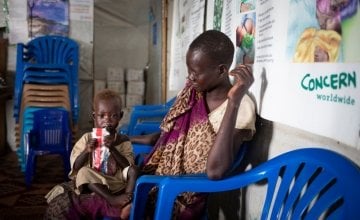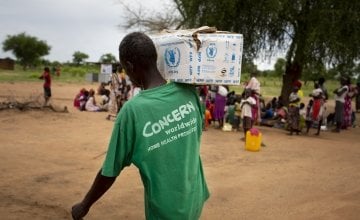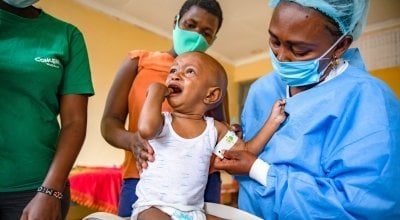
Knowledge Hub
What is famine?
The World Food Programme recently warned that a staggering 50 million people in 45 countries are just one step away from famine, as global hunger reaches record levels and continues to rise. In this blog we explore the circumstances that can lead to famine, which countries are at risk and what we can do to prevent it.
The definition of famine is an ‘extreme scarcity of food’, but for famine to be declared certain conditions must be met. These are:
- One in five households in an area are facing an extreme lack of food
- 30 per cent of children are suffering from acute malnutrition
- Two people out of every 10,000 are dying every day due to starvation or malnutrition and disease.
Famines have occurred throughout history, all over the world. Although there is technically enough food being produced to feed every person on Earth, there are reasons people in famine-affected areas can’t get enough, such as increases in the cost of food or crop production being prevented. These dire circumstances can be created by many factors - from disease outbreaks to recession, conflict, displacement, political unrest and climate change - many of which are at play right now.
What has caused this rise in global hunger?
Since 2014, the number of people affected by hunger across the globe has slowly been on the rise. Increasing conflict, economic crises and climate disasters have made accessing affordable, nutritious food a challenging task in some of the world’s poorest places. Even before the Covid-19 outbreak, projections indicated that the world was not on track to achieve Zero Hunger, one of the United Nation’s Sustainable Development Goals, by 2030. Then, the coronavirus pandemic further disrupted food systems. For those who rely on farming to eat and earn a living, the economic decline led to sharp increases in the cost of tools and seeds, while border closures and travel restrictions reduced food supplies for countries dependent on imports and humanitarian aid.
These circumstances meant that many families struggled to put food on the table, let alone meals with nutritious value. The World Food Programme projected that Covid-19 could push 265 million people into acute food insecurity by the end of last year, almost double 2019’s total.
Currently, in East Africa, climate change, conflict - including the crisis in Ukraine - rising food prices and the Covid-19 pandemic have compounded one of the worst droughts in the region in recent decades. Most people in the region are reliant on the land and their animals to survive and this drought is destroying their livelihoods. Millions of people are leaving their homes and villages to find food, water and pasture. In the most desperate situations, families are selling their livestock to afford food for their children.

Which countries are at risk of famine?
Right now, multiple countries are simultaneously facing the prospect of famine. In other words, they are facing starvation and are doing everything they can to survive. In May, more than half a million people in Ethiopia, South Sudan, Yemen and Madagascar were already at so-called IPC level 5, which means catastrophic or famine-like conditions. Now, this number is much higher and includes countries like Somalia where, for the first time since 2017, there are areas where 213,000 people are facing famine-like conditions.
Concern works in many of these at-risk countries, here is what is happening.
South Sudan
Conflict has plagued South Sudan since it gained independence in 2011, affecting the economy, trade, opportunities for people to earn a living and the delivery of humanitarian aid to those who need it most. All of these things have impacted people’s access to essential food, healthcare and water.
As one of the world’s most climate-change affected countries, droughts, torrential rain and flooding frequently disrupt food production and sanitation in many parts of South Sudan. As such, food insecurity in South Sudan has reached the most extreme levels since independence in 2011, with 8.3 million people comprising 75 per cent of the population facing severe food insecurity.
Somalia
7.7 million people are now in need of humanitarian assistance in Somalia and 800,000 people are displaced due to drought. For the first time since 2017, there are areas where 213,000 people are facing famine-like conditions. Children are dying at malnutrition centres and the numbers attending Concern clinics are climbing week by week.
Currently, half of all the children (approximately 3.6 million) in Somalia are malnourished. The price of fuel, water and food items continue to increase, leading to food insecurity, reduced purchase power and fewer meals, all of which are contributing to acute malnutrition.
In some regions, the most basic food basket has soared in price by over 160%. While food inflation over the last year has globally increased on average by 9%, in Somalia that figure is at 15%.
What is Concern doing?
With the number of people facing extreme hunger growing every day, now is the time for the international community to recognise the severity of the situation and do what they can to avert the possibility of famine.
We have been monitoring the crisis in East Africa as it has been developing, and to help alleviate the situation, we have been supporting health clinics provide nutrition assistance. We have also been delivering emergency cash transfers to affected communities to help people buy nutritious food.
To strengthen resilience and improve access to adequate and safe water, we have been supporting communities by repairing broken boreholes and shallow wells. To support agriculture, we are vaccinating livestock against diseases in an attempt to keep them alive during the drought.
We will continue our longstanding work to address the root causes of hunger and malnutrition in South Sudan and Somalia, as well as many others, by improving vulnerable communities’ resilience and preventing food insecurity.

Will you give a gift today to help families in East Africa survive? £16 can provide two families with a week's worth of emergency food including oil, rice, flour and beans.





